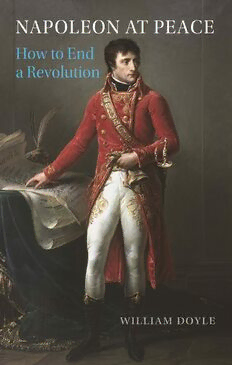
Napoleon at Peace: How to End a Revolution PDF
Preview Napoleon at Peace: How to End a Revolution
NAPOLEON AT PEACE NAPOLEON AT PEACE How to End a Revolution William Doyle reaktion books For Boney’s biggest fan Published by Reaktion Books Ltd Unit 32, Waterside 44–48 Wharf Road London n1 7ux, uk www.reaktionbooks.co.uk First published 2022 Copyright © William Doyle 2022 All rights reserved No part of this publication may be reproduced, stored in a retrieval system, or transmitted, in any form or by any means, electronic, mechanical, photocopying, recording or otherwise, without the prior permission of the publishers Printed and bound in Great Britain by TJ Books Ltd, Padstow, Cornwall A catalogue record for this book is available from the British Library isbn 978 1 78914 617 2 Contents Preface 8 Introduction 11 1 Taking Control 17 2 Winning the War 39 3 Treating with God 75 4 Restoring Authority 115 5 Curbing Disorder 145 6 An Experimental Peace 171 Conclusion 191 Epilogue: Cutting Overseas Losses 197 References 207 A Note on Sources 217 Photo Acknowledgements 221 Index 223 Alexis Chataignier, ‘Bonaparte, First Consul, Putting Away His Sword after the General Peace’, 1802, stipple engraving. Preface ‘So long as Bonaparte was not making war, his prodigious activity was entirely directed within. It was in peace . . . that he shone with the purest brightness, and through his rarest qualities.’1 Count Mathieu Molé apoleon often said, recalled his minister of the interior, NJean-Antoine Chaptal, ‘that when he came to take charge of the government, the French Revolution had not come to an end’.2 It is true that within weeks of taking power he was declaring that it had, but it took almost three years to turn wishful thinking into a reality, celebrated in 1802 with the Peace of Amiens and a concordat with the Catholic Church. This book aims to analyse how it was done. It is not intended as a comprehensive survey of the consulate. Some of its greatest achievements, such as financial stabilization or the Civil Code, get little or no mention. These were establish- ments for the future, but this study quite deliberately does not look forward to or discuss later achievements. It is more about round- ing off a troubled past; laying foundations rather than erecting superstructures. Echoing the first words of Alexis de Tocqueville’s Ancien Régime, it tries to offer not a history of the consulate, but a study on the consulate, concentrating mostly on how what preceded it set an imperative agenda for remedial action. Most of what hap- pened in the French Revolution was neither planned nor foreseen in 1789. But decisions taken in the course of it created intractable problems which prolonged the revolutionary process and polar- ized the country. For a decade, nobody seemed capable of resolving them, with or without violence. The main issues were religion, war 8 Preface and monarchy, all three compounding endemic disorder, both within France and in its overseas empire. Napoleon’s achievement was to find solutions for the three great problems, thereby dimin- ishing much of the disorder that went with them – in metropolitan France at least. His attempted colonial solution failed but still marked the end of the Revolution in a different way. Everything came together with the peace of 1802, marking the closure of the Revolution, which had opened Napoleon’s path to power. It is true that international peace lasted barely a year, and harmony with the Catholic Church not much longer, but what followed began a new phase in the history of France, posing different problems. Each of the problematic legacies of the Revolution receives a separate chapter, culminating in a final survey of the resulting fragile peace. Inevitably this arrangement involves some repeti- tion, hopefully kept to a minimum. An epilogue highlights the consulate’s great failure – to recreate the foundations of France’s flourishing pre-revolutionary Atlantic empire. Each chapter traces its subject to its origins and follows its evolution down to 1799, before analysing how the first consul confronted the problem. Wherever possible, his own earlier attitudes and involvement are identified, widening out into full discussion of how he deployed power when he achieved it. Napoleon’s posthumous fame rests largely on his military achievements. Yet between 1799 and 1805 he only fought one battle, which he nearly lost. Only his rival Jean-Victor Moreau’s later victory, and political accidents in Great Britain, secured the triumphs for which he took so much credit. But Napoleon was a believer in luck, and he knew how to make the most of it. 9
